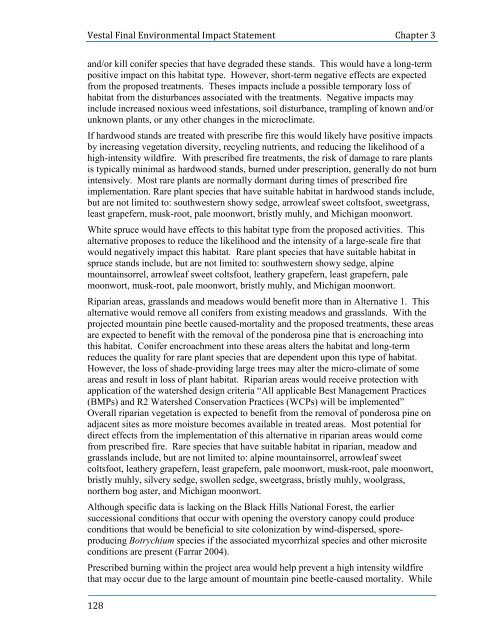Final Environmental Impact Statement
Final Environmental Impact Statement
Final Environmental Impact Statement
Create successful ePaper yourself
Turn your PDF publications into a flip-book with our unique Google optimized e-Paper software.
Vestal <strong>Final</strong> <strong>Environmental</strong> <strong>Impact</strong> <strong>Statement</strong> Chapter 3<br />
and/or kill conifer species that have degraded these stands. This would have a long-term<br />
positive impact on this habitat type. However, short-term negative effects are expected<br />
from the proposed treatments. Theses impacts include a possible temporary loss of<br />
habitat from the disturbances associated with the treatments. Negative impacts may<br />
include increased noxious weed infestations, soil disturbance, trampling of known and/or<br />
unknown plants, or any other changes in the microclimate.<br />
If hardwood stands are treated with prescribe fire this would likely have positive impacts<br />
by increasing vegetation diversity, recycling nutrients, and reducing the likelihood of a<br />
high-intensity wildfire. With prescribed fire treatments, the risk of damage to rare plants<br />
is typically minimal as hardwood stands, burned under prescription, generally do not burn<br />
intensively. Most rare plants are normally dormant during times of prescribed fire<br />
implementation. Rare plant species that have suitable habitat in hardwood stands include,<br />
but are not limited to: southwestern showy sedge, arrowleaf sweet coltsfoot, sweetgrass,<br />
least grapefern, musk-root, pale moonwort, bristly muhly, and Michigan moonwort.<br />
White spruce would have effects to this habitat type from the proposed activities. This<br />
alternative proposes to reduce the likelihood and the intensity of a large-scale fire that<br />
would negatively impact this habitat. Rare plant species that have suitable habitat in<br />
spruce stands include, but are not limited to: southwestern showy sedge, alpine<br />
mountainsorrel, arrowleaf sweet coltsfoot, leathery grapefern, least grapefern, pale<br />
moonwort, musk-root, pale moonwort, bristly muhly, and Michigan moonwort.<br />
Riparian areas, grasslands and meadows would benefit more than in Alternative 1. This<br />
alternative would remove all conifers from existing meadows and grasslands. With the<br />
projected mountain pine beetle caused-mortality and the proposed treatments, these areas<br />
are expected to benefit with the removal of the ponderosa pine that is encroaching into<br />
this habitat. Conifer encroachment into these areas alters the habitat and long-term<br />
reduces the quality for rare plant species that are dependent upon this type of habitat.<br />
However, the loss of shade-providing large trees may alter the micro-climate of some<br />
areas and result in loss of plant habitat. Riparian areas would receive protection with<br />
application of the watershed design criteria “All applicable Best Management Practices<br />
(BMPs) and R2 Watershed Conservation Practices (WCPs) will be implemented”<br />
Overall riparian vegetation is expected to benefit from the removal of ponderosa pine on<br />
adjacent sites as more moisture becomes available in treated areas. Most potential for<br />
direct effects from the implementation of this alternative in riparian areas would come<br />
from prescribed fire. Rare species that have suitable habitat in riparian, meadow and<br />
grasslands include, but are not limited to: alpine mountainsorrel, arrowleaf sweet<br />
coltsfoot, leathery grapefern, least grapefern, pale moonwort, musk-root, pale moonwort,<br />
bristly muhly, silvery sedge, swollen sedge, sweetgrass, bristly muhly, woolgrass,<br />
northern bog aster, and Michigan moonwort.<br />
Although specific data is lacking on the Black Hills National Forest, the earlier<br />
successional conditions that occur with opening the overstory canopy could produce<br />
conditions that would be beneficial to site colonization by wind-dispersed, sporeproducing<br />
Botrychium species if the associated mycorrhizal species and other microsite<br />
conditions are present (Farrar 2004).<br />
Prescribed burning within the project area would help prevent a high intensity wildfire<br />
that may occur due to the large amount of mountain pine beetle-caused mortality. While<br />
128

















